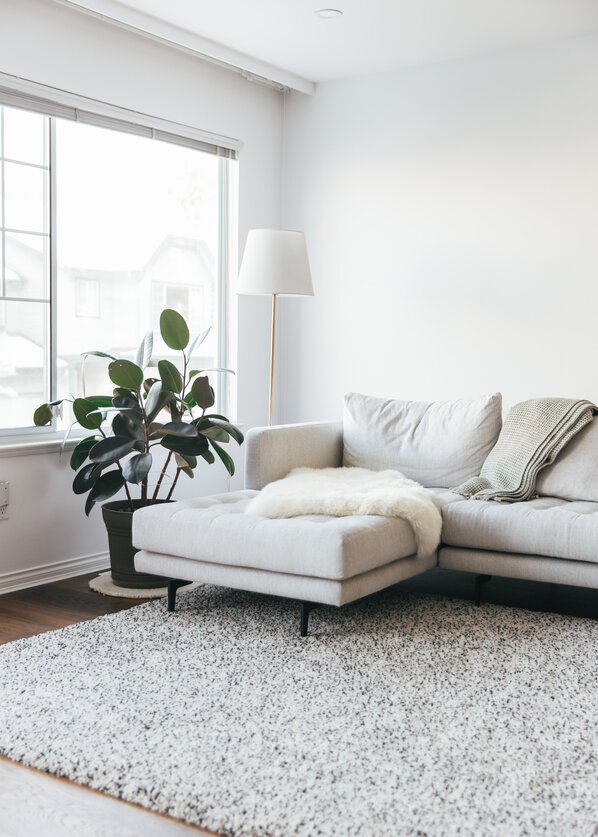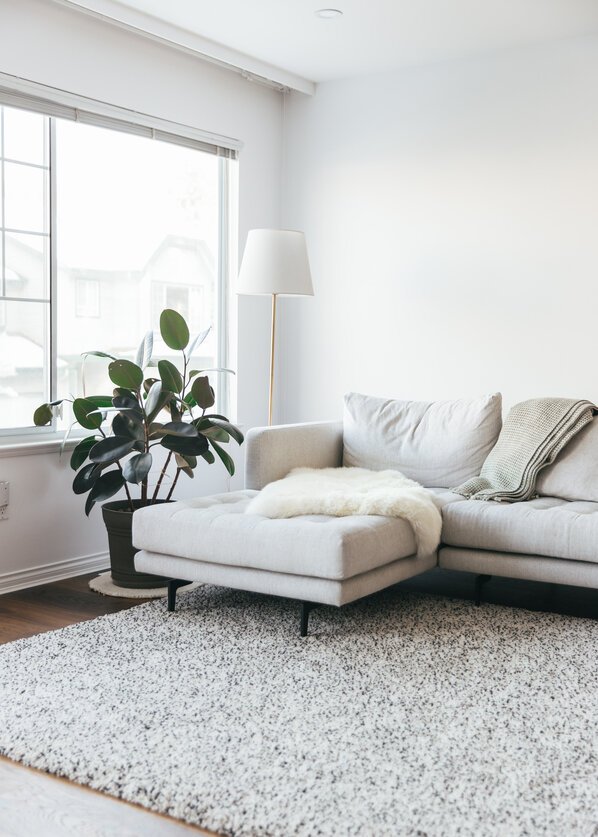
How To Shop For A Rug—Sizes, Materials, And More
Floor Coverings For Every Room In Your Home
I have a tendency to choose homes a few decades older than me (the creakier the floors, the better), so rugs have become a staple element in my space. And let me tell you: The soles of my feet and downstairs neighbors are very, very grateful.
But it isn’t just cozy feet I’m after. Rugs also give a space personality, and they can completely transform an environment. “It’s an element that can be the focal point of a room and/or be the final touch to the perfect layout,” explains Mallory Solomon, CEO and Founder of Salam Hello, a collection of one-of-a-kind rugs, handwoven by Berber women.
Solomon, a rug expert and enthusiast, offers her advice and tips for rug shopping. Because let’s be honest: Rugs can feel like an incredibly grown-up purchase, and especially if you grew up in a rug-less home. But no matter your house age or size, it deserves a cozy floor covering. Even carpeted suburbia deserves a little rug love.
Here’s what we’ll cover:
Size | Materials | Buying Tips | Styling | Caring For Your Rugs
Choosing A Rug Size
For The Living Room
Recommended Sizes | (accent rugs) 4’ x 6’, 5’ x 8’, 6’ x 9’ (area rugs) 8’ x 10’, 9’ x 12’, or 12’ x 14’
“Finding the perfect rug all depends on the room you’re trying to fill,” says Solomon, who recommends taking the layout into consideration while also considering the decor in your space. A large rug can help ground your furniture, while smaller rugs can create conversation zones or serve as accents.
Try putting a smaller rug under your coffee table or have it peek out from beneath the TV console. Allow the front legs of your furniture to touch the rug while the back hangs off, says Solomon. A runner can also work nicely for this, especially under a credenza or in front of a fireplace.
For The Bedroom
Recommend Sizes | 8’ x 10’, 9’ x 12’, 11’ x 15’
For the bedroom, Solomon suggests finding a rug that stretches beyond the bedframe—either on the front-end or to the side tables. Alternatively, you can also flank your bed with two smaller rugs. I have two vintage rugs that aren’t standard sizes on either side of the bed, and the contrast in style and size adds dimension and warmth to the space. Mixing and matching offers a more eclectic feel, Solomon explains.
Elsewhere In The Home
Recommend Sizes | Any!
Rugs can work in just about any nook and cranny in your home—even in the bathroom where bathmats are the assumed option.
“Finding a long runner around the [bathroom] vanity can look quite chic,” explains Solomon. I also love a cozy, high-pile rug in front of my tub or sink, though I recommend drying off completely before stepping out of the bath (you don’t want to drip all over it). “You’ll need to make sure the material can withstand damp environments,” says Solomon.
When choosing a rug for your eating space, Solomon recommends selecting a size that compliments the dining table—ideally 5’ x 7’, 6’ x 6’, 5’ x 8’, 6’ x 9’. This helps create “a base for the chairs even when the guests push the chairs back to get up,” she explains.
Finally, runners are a great value in narrow spaces and can be used as transition pieces or to simply add color and warmth to kitchen floors. Ruggable is a great option for washable runners, especially if you have heavy traffic in and out of your home or four-legged family members.
Need additional help with selecting a rug size? Try this handy visual.
Rug Styles + Materials
When it comes to choosing a rug material, there are quite a few options. While these styles and materials are by no means comprehensive, they will give you a few ideas to start with.
Common Styles
Flatweave. These are low pile or no pile weaving techniques that include Kilims, Hanbels, and Zanafis. Flatweave rugs don’t have as much underfoot cushion, but they are great in high-traffic areas or if you have doors that will swing across the rug. “An added benefit of these styles is the ability to reverse many of these pieces and keep the same design,” says Solomon.
Hand-Knotted. This type of rug is often made on a vertical loom with artisans using natural fiber to loop on the loom and create a series of knots, says Solomon (see the entire process here). “This style incorporates various pile lengths, from the longer Beni Ourain loop to the lower pile of a vintage piece…on average, a hand-knotted Moroccan loom can contain at least 52,000 knots.”
Nontoxic Rug Materials
Wool. This is one of the most popular materials for rugs. Salam Hello uses 100% live wool for their rugs, meaning it’s taken from live sheep, lamb or camel without harm to the animal, explains Solomon. “The wool is healthier and stronger this way.”
An additional interesting note about rugs is to check for the dyes used, especially if you’re looking for something nontoxic for your home. “Our artisans usually card, spin and dye the wool themselves using various spice/plant blends. Henna, pomegranate skin, saffron, coffee grounds, argan shells, florals and indigo stone are a few of the types of natural ingredients the artisans use when dyeing wool.”
Jute. The perfect option for a hardy rug. These rugs are made from jute plant fibers, which are spun into strands and threaded together. I have a jute rug in my kitchen as it’s easy to vacuum and doesn’t show crumbs or the occasional spill. Jute rugs are also pet-friendly, and—despite the coarse appearance—they are soft underfoot. Here are a few sustainable jute rug options.
Cotton. For a soft, budget-friendly material and versatile option, cotton rugs are the way to go. You can easily find these in neutral colors and patterns, and they are a great addition to a children’s bedroom. However, unlike wool, cotton rugs won’t hold up over time and generally fade much quicker, so there is a tradeoff for the price tag.
Additionally, boucherouite (pronounced boo-shay-reet) weave rugs are made with cotton and various recycled clothing and textile scraps, explains Solomon. “These rugs were not originally intended to be sold as they were mostly used in the weavers’ own homes. They tend to be quite vibrant and thick in pile.”
How (And Where) To Buy Rugs
There are two ways I like to shop for rugs: intentionally and—well—not intentionally. Sometimes I set out to find a rug for a specific space, taking measurements and all. Other times, I stumble upon one in a thrift store—like this past summer, when I happened across an 11’ x 13’ vintage silk rug for $250. (I nearly cried; it will forever be my favorite secondhand purchase.) It wasn’t the size or color I was searching for, but I bought it on impulse because, truthfully, it was love at first sight. I then swapped my furniture around and built the rest of the room around it.
However you decide to shop for your rugs, there are a few things I recommend:
Create A Home Mood Board. Similar to creating a fashion mood board, this will help you get a feel for your home’s colors, textures, and overall vibe. You can do this as a tactile activity or online with a tool like Canva.
Familiarize Yourself With Rug Sellers + Brands. There are numerous places to shop for rugs online (once again, may I recommend Salam Hello?), and we’ve curated a list of our favorite nontoxic rug brands. As rugs can be quite an investment, I recommend following your favorite sellers and shops to familiarize yourself with their inventory—especially if you plan to go the vintage route.
“Purchasing a vintage rug can be quite tricky…ensuring your trust the seller is absolute key,” says Solomon. She recommends asking the seller the right questions—like if they know the tribe or artisan who made the piece and if they know the meaning within the design.
“In more traditional vintage rug design, the symbolism is often a wish or depiction of the artisan’s life,” Solomon explains. Another tell-tale way to verify a rug is actually vintage is to look at its shape. “Rugs that are longer but smaller in width were made to fit the old Kasbahs of Morocco,” she says.
Watch For Sales. Additionally, when shopping online, watch for seasonal sales and rug clearouts. Large companies will often do discounts for bank holidays. I also follow a few rug sellers on social media who offer clearance prices on rugs when clearing out inventory.
Shop Secondhand. For me, rugs are about much more than finding a beautiful flooring covering; I love that each rug carries a story—from how it was made to the homes it’s occupied. With proper care and cleaning, rugs can last for generations, and so I much prefer finding rugs that have been loved but still have a lot of life left in them.
Be Patient. Finally, remember that rugs are timeless pieces for your home. It can often take a while to save up or to find the right one for your space. That’s okay! Try not to rush the process. It will be worth it once you find that perfect rug for your home.
Styling Your Rugs
You’ve found the perfect rug for your home—yay! Now it’s time to style it.
Hang them up. Textiles and rugs make wonderful wall decor, especially if you have a large blank canvas and you’re looking to make a statement.
“Don’t forget that rugs can also be used as art,” says Solomon. “Hanging rugs on the wall can be a funky way to highlight the amazing handmade designs that many of these artisans bring to life.” Here are a few tips and tools for turning your rugs into artwork.
Rug layering? Yes, please! This trend continues to grow in popularity—especially with jute rugs, so don’t be scared to mix fabrics. Try these tips for a layered rug look.
Don’t be bound by rules. Play around with your rugs! Move them to odd areas of your home and be creative. There are no hard or fast rules here—you can even place them diagonally or fold them in half. Do what feels best for your home and space—it is yours, after all.
Rug Care Tips
Rugs are hardy and very forgiving, but they do require care and attention to make them last. Try these care tips to ensure longevity:
Shake them out. Yes, rug shaking is a thing—one I don’t do it nearly enough. Solomon recommends (if you have the space) taking your rugs outside and shaking them vigorously once every few weeks. You can also use a vacuum (beater bar on the highest setting). “Flip the rug and vacuum the reverse side to get anything that is deep in the piles as well,” says Solomon.
Rotate your rugs. Rugs should be rotated every three to six months. You’ll also want to remove furniture and vacuum those areas so that bacteria doesn’t form, notes Solomon. “If you spill anything on the rug, you can spot clean the piece with water & dish soap and dab with a towel.”
Give them a comb. As I’m the parent to a very furry pup, I occasionally use a comb on my rug. My dog’s brown hairs like to embed themselves into the weave of my white Berber rug (what was I thinking?), and the comb is gentle and restores a bit of fluff while removing her’s.
Shampoo them once a year. This is a new one for me, and something I only did for the first time last year. After the wildfires in California, my living room rug was a few shades darker from air pollution and ash. I had no idea how easy it was to use a shampoo vacuum cleaner (it took only a few minutes!). The color of the water was enough proof that I should be shampooing my rugs more often. Of course, you’ll want to be careful with vintage rugs and consult the seller about specific care tips.
Ready to make your home a rug haven? I hope these tips will help you find the perfect rug (or rugs—no judgment!) so your feet can feel happy and cushioned and your floors vibrant and warm.
And if you already have rugs you love, tag @thegoodtrade on Instagram and show off your beautiful floor coverings.
Kayti Christian (she/her) is a Senior Editor at The Good Trade. She has a Master’s in Nonfiction Writing from the University of London and is the creator of Feelings Not Aside, a newsletter for sensitive people.

